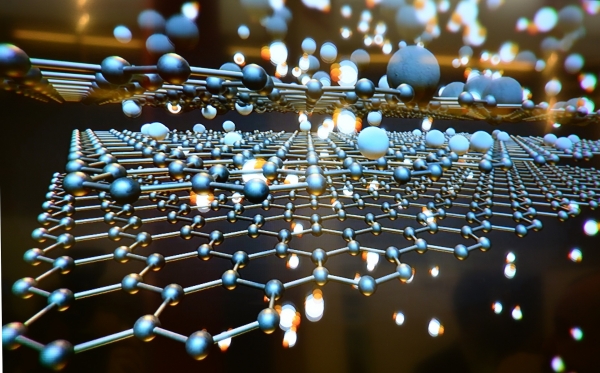Lighter than aluminum, harder than a diamond, more elastic than rubber and tougher than steel. These are only a few of the characteristics of graphene, a super material that acts as an excellent heat and electrical conductor. Due to its features, it is called upon to be a key player in future technological advances in the fields of research, electronics, IT and medicine.
The FQM-346 Organic Chemistry research group at the University of Cordoba came up with the way this material acts in a luminescent way, a new feature it did not have before and that now ushers in a new range of applications. Professor Francisco José Romero Salguero, one of the authors of the research piece, explains that luminescence is a characteristic of some substances which allows them to emit light at a different wave length than the one they absorbed it at. In other words, luminescent materials can emit visible light from energy, a property that makes them useful as photocatalysts and fluorescent tags that can be displayed in macromolecules and biological materials. Now, thanks to this new research, luminescence is added to the long list of services graphene can provide.
This research was published in Chemistry---A European Journal, sponsored by the main chemical societies in Europe, and also involved the work of UCO researchers Juan Amaro Gahete, César Jiménez-Sanchidrián and Dolores Esquivel, along with another Belgian research group. Because of its degree of relevance, this prestigious journal described the article as a hot paper.
Though previous attempts have been made to endow this super material with light properties, all of those were unsuccessful. What really makes graphene special is its hexagonal structure based on highly cohesive carbon atoms by means of a kind of electronic cloud in the shape of a sandwich. If the connection between the atoms in this cloud is interrupted, part of the properties are lost, explains researcher Francisco Romero.
Specifically, overcoming this obstacle is where the success of the research lies. The group was able to incorporate luminescence into this material without affecting its other qualities, thus safeguarding the functionality of its complex structure. In order to do so, europium was integrated into graphene. Europium is a metal that perfectly coordinates with the modified molecules of this super material and is the one that grants it its luminous properties.
The results offer immediate applications, since this luminescent graphene could be used in biological material and for analyzing tissue cells. However, the research goes even further. The use of europium “is just a concept test,” explains University of Cordoba Professor César Jiménez-Sanchidrián.
Henceforth, this study opens the door to the use of a variety of chemical elements that could be combined with graphene to confer new characteristics on it. For instance, if certain kinds of metals are integrated, a magnetic graphene could be generated. Ultimately, it is a line of research that this group, which belongs to the the University Institute of Nanochemistry (abbreviated to IUNAN in Spanish) and the College of Science, will continue to work on with the aim of adding new properties to the list of graphene’s qualities. Doing so will increase the versatility of this substance that holds very promising characteristics and that has already earned the right to be called a material of the future.
References:
Luminescent graphene‐based materials via europium complexation on dipyridylpyridazine‐functionalized graphene sheets. Juan Amaro-Gahete, Anna M. Kaczmarek, Dolores Esquivel, César Jiménez-Sanchidrián, Pascal Van Der Voort,Francisco José Romero-Salguero. 18 March 2019 https://doi.org/10.1002/chem.201900512


